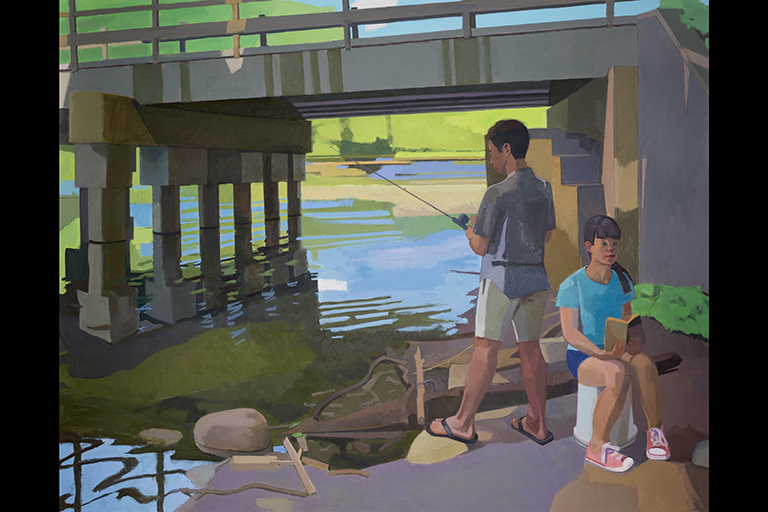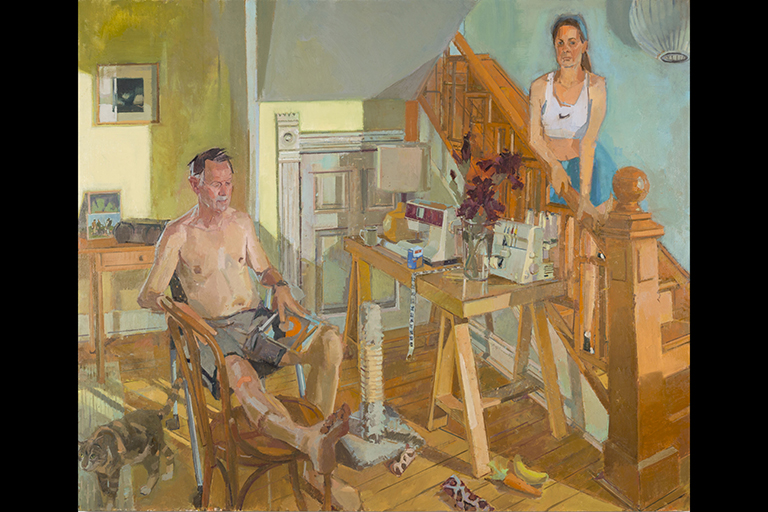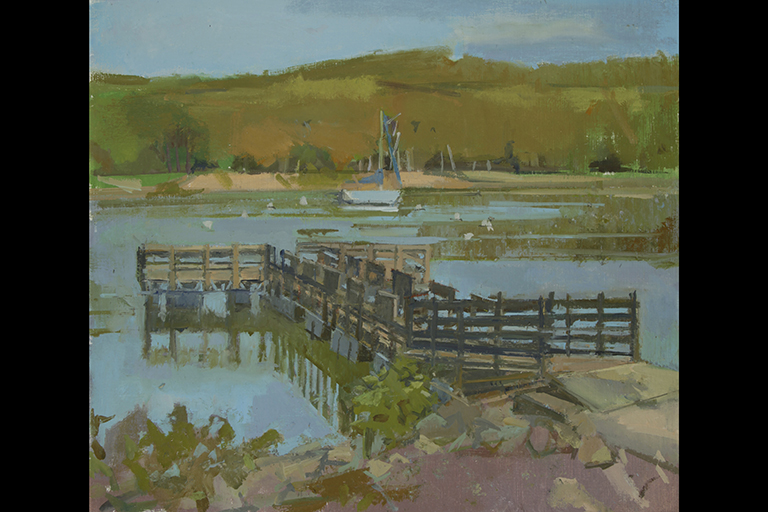In the following Q&A, Tim and Eve share their perspectives, experiences, and a few favorites — from inspiring painters and spots around Bloomington to Russian literature and a rock album.
Who is an artist who has inspired you in recent years? What about their work sings to you?
Eve: I have been inspired by and envious and admiring of many artists over the years. Being an analog person, seeing paintings in person is very important to me. The physical presence and hand of the painter matter to my experience as a viewer. I am always trying to see “how they did it”. I saw the recent show of Manet and Degas at the Met in NY last fall, and, since Tim and I were about to have this show at the Grunwald, it was moving and inspiring to look at an artistic friendship and collaboration that had endured for a lifetime. The show was revealing as to how the two artists influenced each other, and how their fundamental temperaments differed, while they maintained similar interests and kind of “egged” each other on. I was also very moved by the grittiness and autobiographical quality of the Guston show at the National Gallery last summer.
Tim: In relation to artists that inspire me and that I think about this could be a very long list! Two artists that are important to me and that I turn to repeatedly are the French Nabi artist Edouard Vuillard and the American 20th century artist Fairfield Porter who also admired Vuillard. I suppose the qualities that I respond to in both artists are their love of the particular and that their use of the material of paint is undisguised and visceral. Eve and I have plans to visit Great Spruce Head Island in Maine where Porter painted for much of his life later this summer.
A few artists that I have been thinking about recently are Kerry James Marshall, Hurvin Anderson and Amy Sillman – again this could be a much longer list. Marshall and Anderson are both Black – Marshall is from the US while Anderson is British of Jamaican ancestry. Marshall paints ambitious figure compositions through a Black lens that might include a picnic or a beauty parlor and that slyly allude to paintings by Manet or Holbein. Anderson paints beautiful tropical landscapes that might include a gate or fence meant to obstruct the viewer and might also be a commentary on privilege and exclusion. Sillman primarily paints muscular and eccentric abstractions with occasional forays into representational painting.
Are there any physical places that notably move you to paint? Is there a particular way you suggest people approach the painting of a landscape?
Eve: I enjoy painting landscapes, but I am basically a city person who lives inside! I had never painted landscapes until I moved to Indiana and, when I was young, I think I thought of nature as something fundamentally alien. Since being here, and having traveled to paint landscape, it has become a fruitful part of my practice. But I think most of my interest lies in the idea of an interior space both physically and mentally.
Tim:I have painted the landscape of Bloomington in town on the street. I have done may paintings of our old Lincoln Street neighborhood on the south side of town, but I also frequently paint at Griffy Lake and on Lake Monroe. The spot I have painted the most has been near the marina at Paynetown on Lake Monroe. I like the presence of water and how the landscape opens up. I have a special affection for painting in Michigan particularly on the Leelanau Peninsula. Part of my childhood was spent growing up near Grand Rapids, so I know the state pretty well and respond to it visually as well as emotionally.
As far as advice on painting you can’t go wrong with “Hawthorne on Painting” which is a collection of aphorisms by Charles Hawthorne on painting collected by his students. I have my students read it each semester. His painting gospel advocates painting directly in patches or “spots” of related color without use of an elaborate under drawing. Hawthorne had been a student of William Merritt Chase but was, more importantly to me, the teacher of Edwin Dickinson, a guru to perceptual painters. Lennart Anderson studied with Dickinson for a short time in the 50s. Both Eve and I studied with Lennart at Brooklyn College. I like to think that there is a direct line from that book to us.
Has anything you’ve read recently really resonated with you? Does it relate with how you approach and make your art?
Tim: Last year I read George Saunders’ collection of Russian short stories with his commentary on them, “A Swim in a Pond in the Rain”. The collection includes stories by Tolstoy, Turgenev and Chekhov. The commentary is good and thoughtful and prodded me to think about the stories more deeply. The stories are all terrific but I probably responded to the Chekhov stories the most to the point that they inspired me to pick up a collection of his stories which I have been reading since the New Year. Chekhov has a keen eye for visual detail – his descriptions of landscape are particularly vivid but he also has a way of communicating the essence of people through short, sharp descriptions of them and their surroundings and the social dynamics between people but he does not explicitly spell everything out – that’s the reader’s job. As an author he has some distance. He doesn’t tell the reader what to think but, even so, he manages to communicate great empathy and pathos. I might be responding to the stories at a deeper level I am now since reading them later in life.
I hope I do this too (at least a little) as I paint.
What is one of your favorite music albums? What do you love about it?
Eve: Again, at my age “favorite” is a hard question-I have had so many musical taste changes over the years. One thing the show reminded me of, though, was the fact that I have often listened to one album continually for a given painting, to keep me in a certain frame of mind or mood, and often that album will find its way into the painting, almost as an homage. In the still life "Voyage" I hit the replay button on The Smiths album "Meat is Murder" almost all day long. Inevitably a gun and a raw steak found their way into that painting along with the cd cover.
Tim: I suppose that I listen to albums a little less frequently than I have in years past – I listen to the radio more – but two perennial favorites have been a collection of piano pieces by Erik Satie and the Miles Davis album “Kind of Blue”. Both records are fully capable of pulling me into a dream state – for which I am ever grateful.
Anything else you want to share?
Eve: Movies have always been a big source of inspiration for me. I have been watching some older movies with my MFA Painting seminar and I realize how much I love the real time, slow uncut camerawork of movies from the 70s, which is really when I came of age. And maybe some of the deliberately “bad” production values. As an aesthetic, that filters into my work.
Tim: Eve has been watching movies with her grad Painting Seminar class. Most recently the film was “Andrei Rublev” by Andrei Tarkovsky – another Russian! What a beautiful, hypnotic and occasionally disturbing film that has the ability to warp time.









